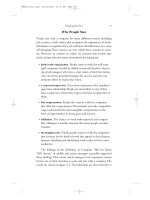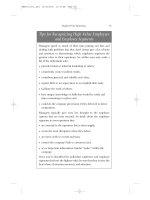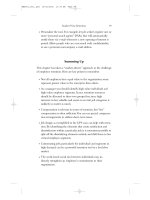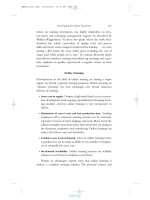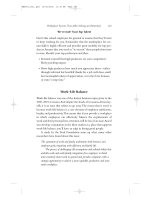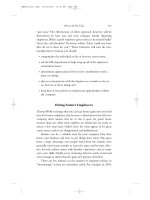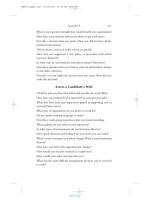Tài liệu Hiring and Keeping the Best People 23 doc
Bạn đang xem bản rút gọn của tài liệu. Xem và tải ngay bản đầy đủ của tài liệu tại đây (117.27 KB, 8 trang )
tions with notes about how to use them and how to follow up.The ques-
tions are categorized by purpose and by type of job candidate.
Hattersley, Michael.“Conducting a Great Job Interview,” Harvard Man-
agement Update, March 1997. This article focuses on how to get beyond the
“pat” question-and-answer formula of the well-prepared interview candi-
date.
Kanter,Arnold B. The Essential Book of Interviewing. New York: Random
House, 1995. Kanter’s book gives interviewers and interviewees the tech-
niques to master the interview process. He explains how to prepare for an
interview, ask the right questions and avoid the wrong ones, and make
decisions.
Recruiting
“Online Hiring? Do It Right,” Harvard Management Update, February
2000. Managers can find new employees through the Web—but not just by
posting job openings.The Web allows managers to reach larger numbers of
potential candidates, in venues that weren’t available in the past. It also
allows companies to pinpoint their recruiting efforts and to set themselves
apart from competitors through creative electronic tactics. This article
offers some guidelines, and a sidebar entitled “Keep Web Hiring in Per-
spective” describes the negative aspects of online hiring.
Cappelli, Peter. “Making the Most of On-Line Recruiting,” Harvard
Business Review 79, no. 3 (March 2001): 139–146.This article examines hir-
ing right through the lens of recruiting technology, showing how it lets
companies find, attract, and screen candidates.
Retention
The Center for Organizational Research. A Research Report on the Brave
New World of Recruiting and Retention: Facts,Trends, Practices, and Strategies.
Lexington, MA: Linkage, Inc., 2000. This article shows managers how to
implement a key retention strategy: helping employees redefine their cur-
rent roles so that the work better matches their core business interests,
work reward values, and skills.
Dobbs, Kevin. “Winning the Retention Game,” Training, September
1999. In this selection, Dobbs affirms the importance of designing
unique, creative strategies for retention—emphasizing that “one-size-fits-
all” approaches no longer work. He outlines the new rules driving
turnover patterns and provides tips for combating attrition through cre-
ative perks.
O’Reilly, Charles and Jeffrey Pfeffer,“Southwest Airlines: Using Human
Resources for Competitive Advantage (A),” Case HR1A. Stanford: Stan-
ford University Graduate School of Business, 1995. This case study pro-
For Further Reading 163
HBE001_FurtherRead_.qxd 10/02/2002 11:49 AM Page 163
vides a revealing inside look at the work environment at SWA and the fea-
tures that make its employees loyal and customer-directed.
Training and Career Development
Cappelli, Peter. The New Deal At Work: Managing the Market-Driven Work-
force. Boston: Harvard Business School Press, 1997. The author brings his
“market-driven” approach to human resources to a very good section on
the dilemma that employers created when they broke the traditional
unwritten contract with their employees. The free agency climate that
resulted has made training and career development risky. He explains how
some firms have responded by asking employees to pay for their own train-
ing, for example, or take responsibility for reimbursing training costs if they
defect within certain time periods.
Olesen, Margaret. “What Makes Employees Stay,” Training & Dev-
elopment, October 1999. Investing in training can help employees move
forward in their professional development—and gives your firm a major
competitive edge in the war for talent.This article explores the impact of
training on retention and includes tips and three case studies.
Work-Life Balance
For companies considering a telework program, the International Tele-
work Association & Council (ITAC) offers its “e-Work Guide: How to
Make Telework Work for Your Organization.”The 100-page guide ($99)
consists of recommended practices from telework experts. Check it out at
www.telecommute.org/brp/ework_guide.shtml.
AT&T likewise has lots of information on getting started in telework. It
also sells consulting services to companies that want to set up programs. Its
site, www.att.com/telework/get_started, has information for employees,
managers, and companies on this subject.
Moore, Jo-Ellen.“Are You Burning Out Valuable Resources?” HR Mag-
azine, January 1999. Burnout from work exhaustion is a main reason that
people leave their jobs. This articles shows you what burnout looks like,
who’s most susceptible (your top performers!), and how you can manage
exhausted employees.
164 For Further Reading
HBE001_FurtherRead_.qxd 10/02/2002 11:49 AM Page 164
alumni programs, 138
baby boomers, 71–73
burnout
management of, 122
re-recruitment of top employ-
ees, 123
signs and causes, 119–120
strategies for avoiding, 120–122
work-life balance and, 133–134
career development. See also train-
ing
career ladders, 108–110
mentors, 110–111
case interviewing, 40–42
cognitive ability tests, 54
company culture
changing, 117–119
employee feedback about, 117
hiring for the right fit, 49–50,
51f
work culture survey, 51f
work-life balance and, 133
contractors and retention, 69
corporate institutions, 105
cover letters and résumés, 9
C performers, 78, 112–113
culture, company. See company
culture
customer satisfaction
retention and, 62–63
service-profit chain and, 64–65
decision-making matrix for evalu-
ating candidates, 21, 22t
defection detection, 83, 84
demographics, work force
female employees, 73–74
over-50 workers, 71–73
retention and, 66, 67f
younger workers, 70–71
development, career. See career
development
distance learning, 107–108
education/experience of a candi-
date, 3–4
embedded personal interests
benefits of using to hire, 47–48
core interests and categories
overview, 42–43, 44t,45t,46t
in counseling and mentoring, 46
creative production, 45–46
determining a candidate’s, 49
in enterprise control, 47
in language and ideas, 47
in managing people and rela-
tionships, 46–47
in quantitative analysis, 43–45
165
Index
HBE001_Index_.qxd 10/02/2002 11:50 AM Page 165
embedded personal interests (con-
tinued)
in technology application, 43
in theories and concepts, 45
employee retention. See retention
employee turnover. See turnover
employee value proposition (EVP),
76–77
employment agencies, 38
evaluating candidates
common mistakes, 23
decision-making matrix, 21, 22t
reference checks, 23–25
executive search firms, 38
experience requirements for a
candidate, 3–4
fit determination. See embedded
personal interests
flexible scheduling, 131–132
free agents, 68
free rider problem, 103–104
glossary, 159–160
head-hunters, 38
hiring
common mistakes, 27
company culture and, 49–50, 51f
decision making, 25–26
defining job requirements, 3–5, 6
embedded personal interests and
(see embedded personal
interests)
evaluation of candidates (see
evaluating candidates)
interviews (see interviewing
candidates)
job description development,
5–7
job offer, 26, 28
process improvement, 28–29
psychological testing (see pre-
employment tests)
recruiting candidates (see recruit-
ing)
rehiring former employees,
139–141
summary, 29–30, 55–56
illegal interview questions
anti-discrimination regulations,
37
examples of, 19, 21, 155–158
pre-employment tests issues,
54–55
in-person interviews, 11
intellectual capital importance,
60–62
interest tests, 54
Internet use for recruiting. See
online recruiting
interviewing candidates
body, 14–16
case interviewing, 40–42
closing, 16, 18, 153
exit interviews, 141
illegal questions (see illegal
interview questions)
opening, 12–14
preparation, 12, 13f
questions to ask, 18–19, 149–
152, 153
résumé statements and, 15
stages of, 10–11
structured versus unstructured
interviews, 11–12
styles, 17–18
tips, 20
job customization as a retention
tool, 95–96
166 Index
HBE001_Index_.qxd 10/02/2002 11:50 AM Page 166
job description development, 5–7,
147–148
job redesign as a retention tool,
94–95
job requirements, defining, 3–5, 6
Kelleher, Herb, 49, 79
ladders, career, 108–110
legal issues in interviewing. See
illegal interview questions
life interests. See embedded per-
sonal interests
loyalty and social ties as a retention
tool, 97
mentors, 110–111
micro- and macrocultures in a
company, 49–50
offer, job, 26, 28
online recruiting
anti-discrimination regulations,
37
benefits of use, 32–33
four-step approach, 35–37
internal labor market and, 98–99
retention and, 68
tips for Internet use, 33–35
online training, 107–108
on-the-job training, 104, 105
part-timers and retention, 69
pay as a retention tool, 93–94
personal characteristics
defining for a job description,
4–5, 6
interests and retention (see
embedded personal interests)
pre-employment tests, 53–55
Predictive Index, 53
pre-employment tests
legal issues, 54–55
reasons to use, 52
tips for use, 53–55
psychological testing. See pre-
employment tests
recruiters, professional, 38–40
recruiting
case interviewing, 40–42
channels available, 7–8
job description sample, 147–148
online (see online recruiting)
professional recruiter use, 38–40
re-recruitment of top employ-
ees, 123
résumé screening, 8–10
tips, 8
redeployment to avoid burnout,
121–122
reference checks, 23–25
referrals for recruitment, 8
résumés
interview questions and, 15
screening of, 8–10, 34–35, 36
retention
analogy to marketing segments,
88–90
company examples, 79–81
cultural expectations and, 67
customer satisfaction and, 62–63
defection detection, 83, 84
demographics and, 66, 67f
diversity challenges, 69–74
economic and cultural trends,
67–69
employee contentment statistics,
59–60
employee segments and, 90, 91,
92
exit interviews, 141
Index 167
HBE001_Index_.qxd 10/02/2002 11:50 AM Page 167
TEAMFLY
Team-Fly
®
retention (continued)
intellectual capital importance,
60–62
quality of managers and supervi-
sors and, 78
reasons people leave, 77, 79
reasons people stay, 75–77
recognizing high-value employ-
ees/employee segments, 91
service-profit chain and, 64–65
stay interview, 83
strategies for, 81–83, 93–99
summary, 84–85, 99–100
turnover costs, 63, 65–66
turnover rates, 61f
SAS Institute, 80–81, 93
Sears Roebuck, 62
service-profit chain, 64–65
social ties as a retention tool, 96–97
software for online recruiting,
34–35
Southwest Airlines, 48, 79–80, 93
stay interview, 83
technical recruiters, 38
technical skills and retention, 68
telephone-screening interview,
10–11
telework, 127, 129–131
temporary workers and retention,
69
360-degree feedback, 83
training. See also career develop-
ment
approaches to, 104–106
benefits to companies, 102
C performers, 78, 112–113
free rider problem, 103–104
online, 107–108
payback from, 106–107
summary, 113–114
tips, 114
turnover
business impact, 136–137
calculator for, 65
costs from, 63, 65–66
economic benefits of reducing,
80–81
exit interviews and, 141
maintaining relationships,
138–139
rates, 61f
rehiring former employees,
139–141
summary, 142
UPS, 90
Usenet, 34
war for talent, 59
women
gender/retention issues, 73–74
percentage in the work force,
124
work-life balance and, 132–133
work culture. See company culture
work-life balance
burnout and, 133–134
flexible work schedules, 131–132
principles for, 125–127
relation to business performance,
123–124
summary, 134
telework, 127, 129–131
tips for, 128
women and, 132–133
workers’ attitudes toward, 68
working hours escalation, 124
168 Index
HBE001_Index_.qxd 10/02/2002 11:50 AM Page 168
Peter Cappelli is the George W.Taylor Professor of Management at
The Wharton School and Director of Wharton’s Center for Human
Resources.He is also a Research Associate at the National Bureau of
Economic Research in Cambridge, MA, and a member of the exec-
utive committee of the National Center on Post-Secondary
Improvement for the U.S. Department of Education at Stanford
University. He has degrees in industrial relations from Cornell
University and in labor economics from Oxford, where he was a
Fulbright Scholar. He has been a Guest Scholar at the Brookings
Institution, a German Marshall Fund Fellow, and a faculty member
at MIT, the University of Illinois, and the University of California at
Berkeley, as well as The Wharton School. He was a staff member on
the Secretary of Labor’s Commission on Workforce Quality and
Labor Market Efficiency from 1988–90 and was recently named by
Vault.com as one the twenty-five most important people working in
the area of human capital.
Professor Cappelli’s research has examined changes in the work-
place and their effects on employers. His publications include
Change at Work (Oxford University Press, 1997), a major study for
the National Planning Association on the restructuring of U.S.
industry and its effects on employees, and The New Deal at Work:
Managing the Market-Driven Workforce (Harvard Business School
Press, 1999), which examines the challenges associated with the
decline in lifetime employment relationships. His recent work on
169
About the Subject Advisor
HBE001_AbouttheAdvisor.qxd 10/02/2002 11:48 AM Page 169
managing retention and on new approaches to recruiting appears in
the Harvard Business Review.
About the Writer
Richard Luecke is the writer of several books in the Harvard Busi-
ness Essentials series. Based in Salem, Massachusetts, Mr. Luecke has
authored or developed over thirty books and dozens of articles on a
wide range of business subjects. He has an M.B.A. from the Univer-
sity of St.Thomas.
170 About the Subject Advisor
HBE001_AbouttheAdvisor.qxd 10/02/2002 11:48 AM Page 170
